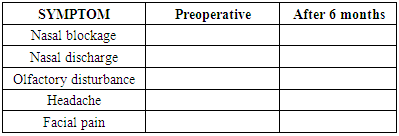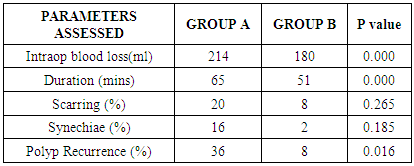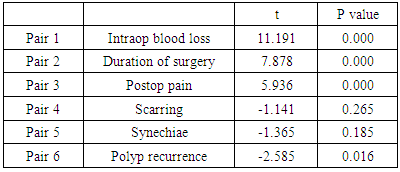-
Paper Information
- Previous Paper
- Paper Submission
-
Journal Information
- About This Journal
- Editorial Board
- Current Issue
- Archive
- Author Guidelines
- Contact Us
Research in Otolaryngology
p-ISSN: 2326-1307 e-ISSN: 2326-1323
2017; 6(1): 10-15
doi:10.5923/j.otolaryn.20170601.03

Conventional versus Microdebrider Assisted Endoscopic Sinus Surgery for Sinonasal Polyposis - A Comparative Study
N. Kanishka Varman, Borligegowda Viswanatha, Mohammed Hussain S., Maliyappanahalli Siddappa Vijayashree, Shambulinga Killera
Otorhinolaryngology Department, Bangalore Medical College & Research Institute, Bangalore, India
Correspondence to: Borligegowda Viswanatha, Otorhinolaryngology Department, Bangalore Medical College & Research Institute, Bangalore, India.
| Email: |  |
Copyright © 2017 Scientific & Academic Publishing. All Rights Reserved.
This work is licensed under the Creative Commons Attribution International License (CC BY).
http://creativecommons.org/licenses/by/4.0/

BACKGROUND: Sinonasal polyposis is frequently encountered in rhinology practice and has a significant effect on the quality of life. Functional Endoscopic Sinus Surgery with conventional instruments or powered tools is the modality of choice. The objective of our study was to compare the efficacy of microdebrider assisted endoscopic sinus surgery versus conventional instruments and to assess the intraoperative and postoperative outcomes in both methods. METHODS: A prospective study was conducted on 50 patients with bilateral sinonasal polyposis of which 25 patients underwent conventional polypectomy and the rest 25 patients underwent microdebrider assisted endoscopic polypectomy. The study aimed at comparing the intraoperative (blood loss, duration of surgery) and post operative results (postoperative pain, symptoms, scarring, synechiae formation, polyp recurrence) and the data was statistically analysed. RESULTS: Paired t test was used for statistical analysis of the data obtained. The intraoperative mean blood loss and duration of surgery were significantly higher in the conventional group (p-value <0.001) as compared to microdebrider group. Postoperative pain in both groups were compared and was significantly higher in the conventional group (p-value<0.001). Scarring, synechiae formation and recurrence of polyps were significantly higher in the conventional group in our follow up period of 6 months, however results were not statistically significant. CONCLUSION: Microdebrider assisted polypectomy is precise, relatively bloodless surgery, with cutting and suction in a single tool making the duration of surgery shorter with minimal trauma and thus offers better intraoperative and postoperative outcomes and better therapeutic results in comparison to endoscopic sinus surgery using conventional instruments.
Keywords: Sinonasal polyposis, Conventional instruments, Functional endoscopic sinus surgery, Microdebrider
Cite this paper: N. Kanishka Varman, Borligegowda Viswanatha, Mohammed Hussain S., Maliyappanahalli Siddappa Vijayashree, Shambulinga Killera, Conventional versus Microdebrider Assisted Endoscopic Sinus Surgery for Sinonasal Polyposis - A Comparative Study, Research in Otolaryngology, Vol. 6 No. 1, 2017, pp. 10-15. doi: 10.5923/j.otolaryn.20170601.03.
1. Introduction
- Sinonasal polyps are edematous prolapsed mucosa of the nose and paranasal sinuses affecting about 4% of general population. [1] The prevalence rate of nasal polyposis in the general population is considered to be around 4% and it increases with age, reaching a peak in individuals aged 50yrs and above with a male: female ratio of 2:1. Sinonasal polyposis has a significant effect on the quality of life. [2] Although it is easy to diagnose this condition, it is yet a challenge for otorhinolaryngologists, because of its poorly understood etiopathogenesis, poor impact of therapeutic intervention and frequent recurrences. As it has a high tendency to recur and is associated with the risk of systemic side effects with the use of steroids, surgical management seems to be a far more favorable option. Thus microdebrider assisted endoscopic sinus surgery offers better therapeutic results in comparison to endoscopic sinus surgery with the conventional instruments. [3, 4]The principle of this technique is to remove the pathologic tissue from the ostiomeatal complex and to restore the corrupted mucociliary clearance and improve sinus ventilation without harming normal nasal physiology and anatomy. This method provides satisfactory results by making dissection faster, almost bloodless and safe, and allows rapid healing of tissues without causing much harm to the normal mucosa. Thus the aim of the study is to evaluate the efficiency of microdebrider in endoscopic sinus surgery versus conventional instruments and to compare intraoperative and postoperative results in both the methods.
2. Materials and Methods
- A prospective study was conducted on 50 patients with bilateral sinonasal polyposis in the Department of Otorhinolaryngology, Bangalore Medical College and Research Institute between June 2015 and June 2016.Patients included in the study were chosen based on the following criteriaŸ All unoperated cases of bilateral sinonasal polyposis with clinical features of nasal blockage, nasal discharge, olfactory disturbance, headache and facial pain were considered for the study. Modified Lund–Mackay scoring system was used for assessing patient symptoms using visual analogue scores (VAS) and a total score of equal to or greater than 20 was selected as a case for the study. Visual analogue scores (VAS) range from 0 to 10 where 0 = no symptoms and 10 = great severity of symptoms. (Table 1). [5]
|
|
3. Results
- Our study included 25 patients (16 Male and 9 Female) in Group A and 25 patients (13 Male and 12 Female) in Group B. Age distribution of patients ranged from 20 to 55 years. Intraoperative blood loss and duration for each of the procedures was tabulated and analysed statistically using paired t test and the intraoperative mean blood loss and duration of surgery were significantly higher in the conventional group (p-value <0.001) as compared to microdebrider group {Table-3, Graph-1}. Postoperative pain in both groups were compared and was significantly higher in Group A (p-value<0.001). Also scarring, synechiae formation and recurrence of polyps were significantly higher in the conventional group as compared to the microdebrider group in our follow up period of 6 months {Graph- 2,3,4}, however on statistical analysis P value was insignificant (Table 4). However our patients showed symptomatic relief with both procedures and with marked improvement seen in Group B patients which was analysed using Visual Analouge Method over a follow up period of 6 months.
|
|
 | Graph 1. Showing comparison of Intraoperative blood loss in both the groups |
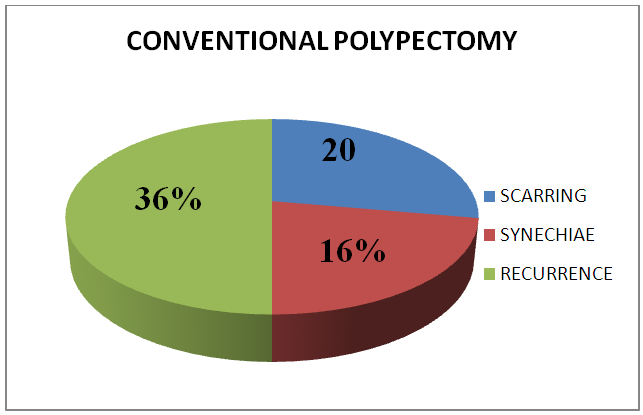 | Graph 2. Showing postoperative results in conventional polypectomy |
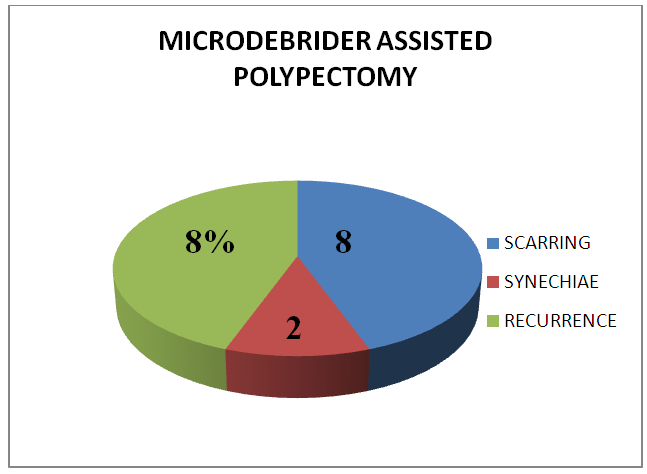 | Graph 3. Showing postoperative results in conventional polypectomy |
 | Graph 4. Showing comparison of postoperative results in both groups |
4. Discussion
- Nasal polyposis can be treated either by medical and /or surgical management. However in patients who remain refractory to medical treatment, definitive surgery may become essential in order to reduce the amount of inflammatory tissue, provide adequate drainage of sinuses and improve ventilation of the paranasal sinuses. [6] Earlier severalcases were treated by simple polypectomy. Ever since the advent of endoscopes, such patients have been referred to rhino surgeons for functional endoscopic sinus surgery, preceded by a CT scan.Microdebriders are commonly used powered instruments in endoscopic sinus surgery and has been found to offer better postoperative results when compared to conventional instruments used in endoscopic sinus surgery. This instrument is perhaps one of the most important innovations that has been brought into the field of rhinology. The microdebrider thus provides satisfactory results by making dissection faster, almost bloodless and safe, and lets rapid healing of tissues without harming normal mucosa. Thus, powered instruments achieve a good surgical field and also allow the intact mucosa to be protected during dissection. [7, 8] There is also a possibility of getting biopsy specimens during surgery for histopathologic examination. [8, 9] Magdy et al, reported that dryness of the operative field was better with powered instruments (microdebrider) as compared to conventional instruments. [10] Krouse et al, reported an average of 19.5 ml of blood in powered instruments and 44.5 ml of blood in standard cases thus suggesting that microdebrider assisted polypectomy had lesser intraoperative blood loss in comparison to conventional polypectomy. [11] The faster the blades move the smaller the pieces, while the slower the blades are set, the larger the pieces. The quality of the cuts are precise and thus minimizes tissue trauma and stripping. This avoids scarring and resultant postoperative complications such as scarring, synechiae formation, recurannce of polyps and also has better postoperative outcome with respect to patients symptomatic relief. Bernstein et al. (1998) presented 40 cases of endoscopic sinus surgery performed with the microdebrider which showed rapid mucosal healing, minimal crust formation and a low incidence of synechiae formation. [7] Kim Dalziel et al. (2006) in his review of endoscopic sinus surgery for nasal polyps found symptomatic improvement in 78–88% and median recurrence rate of 20%. [12] A prospective study conducted by Ghera B et al showed that scarring/synechiae formations had a lower incidence with the use of microdebriders due to mucosal preservation and minimal tissue trauma. [13] Kakkar V et al, Singh R et al, Kursat et al, all compared microdebrider assisted endoscopic sinus surgery with conventional endoscopic sinus surgery. They all reported better postoperative scores with microdebriders. [4, 14, 15] Sauer et al and Selivanova et al also reported better postoperative results with microdebriders. [16, 17]The microdebrider allows the surgeon to work continuously without having to remove the instrument which may otherwise be necessary while using conventional instruments with endoscopic surgery and thus reduces the time taken for the procedure. [18] Cornet ME et al, found a 37% longer operating time with conventional instruments. [19] Another study by Dokuz Eylul University, Izmer, Turkey (2002) showed that microdebrider is easier and faster way of resecting polyps. [20] A recent retrospective case control study by Kumar and Sindwani (2009) showed that bipolar microdebrider significantly reduces intra operative blood loss and operating time in nasal polyp surgery. [21] Conventional instruments (Blakesley forceps) on the other hand can cause more trauma due to their tearing and stripping action and result in excessive scarring, synechiae formation and postoperative complications. They also create a more bloody surgical field and mucosal preservation is also minimal due to their stripping action. [22] Bernstein et al, reported that conventional endoscopic surgery with Blakesley forceps was more traumatic. [7] Setliff and Parsons (1994), who introduced microdebrider for nasal surgery, observed limited blood loss, accelerated healing time, reduced synechiae formation and decreased middle turbinate trauma. [23]However one disadvantage of the microdebrider being a powered tool is that it offers less tactile sensation to the surgeon performing the surgery. This makes it difficult to determine certain features of the soft tissue around the sinus cavity. This becomes less of a concern when extracting bone with the microdebrider.Complications associated with using a microdebrider are quite rare; however it is important to understand any of the risks that may be associated with the surgery. Due to the use of relatively high-powered suction, there have been some reports of damage that have occurred. Bhatti and colleagues have reported two cases of ocular injury and has been speculated to be related to the power of the suction on the microdebrider. [24] Another case of subarachnoid hemorrhage was also reported by Berenhalz and colleagues. [25] These types of reports are very rare and microdebriders are used throughout the world on a daily basis. In general microdebriders are safe tools used for sinus surgery.
5. Conclusions
- In comparison to conventional endoscopic sinus surgery, microdebrider assisted endoscopic sinus surgery is therapeutically far more effective. Microdebriders are powered tools and since cutting and suction are combined in a single tool the duration of surgery is shorter. It also offers a relatively bloodless field thus making visualization better for the operating surgeon and thus reducing trauma. As they are designed to precisely cut the tissue, mucosal preservation is better and thus postoperatively scarring and synechiae formation are minimized and healing occurs faster and postoperative complications are lesser and thus the patients shows a marked symptomatic improvement following microdebrider assisted endoscopic sinus surgery.
 Abstract
Abstract Reference
Reference Full-Text PDF
Full-Text PDF Full-text HTML
Full-text HTML